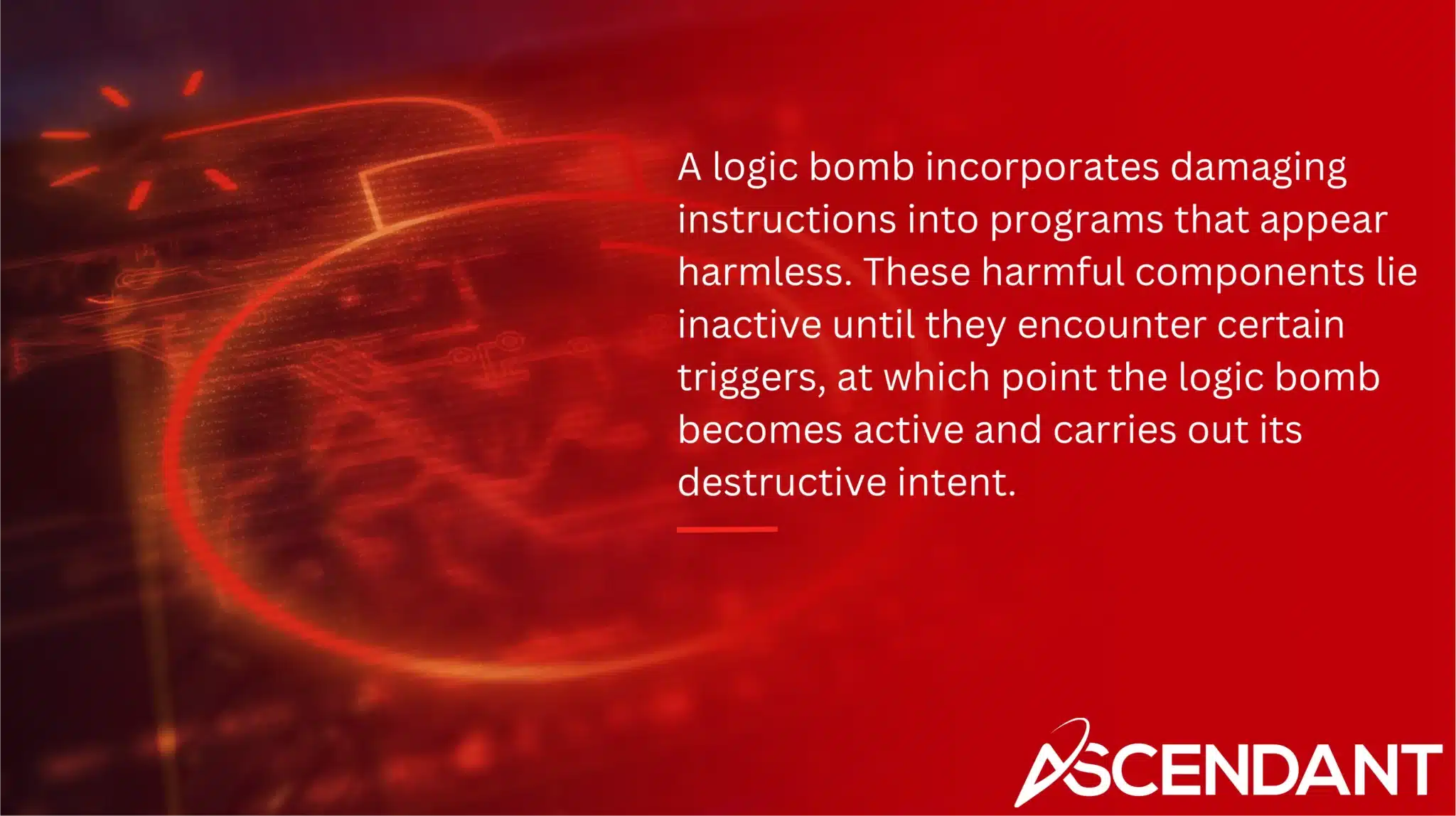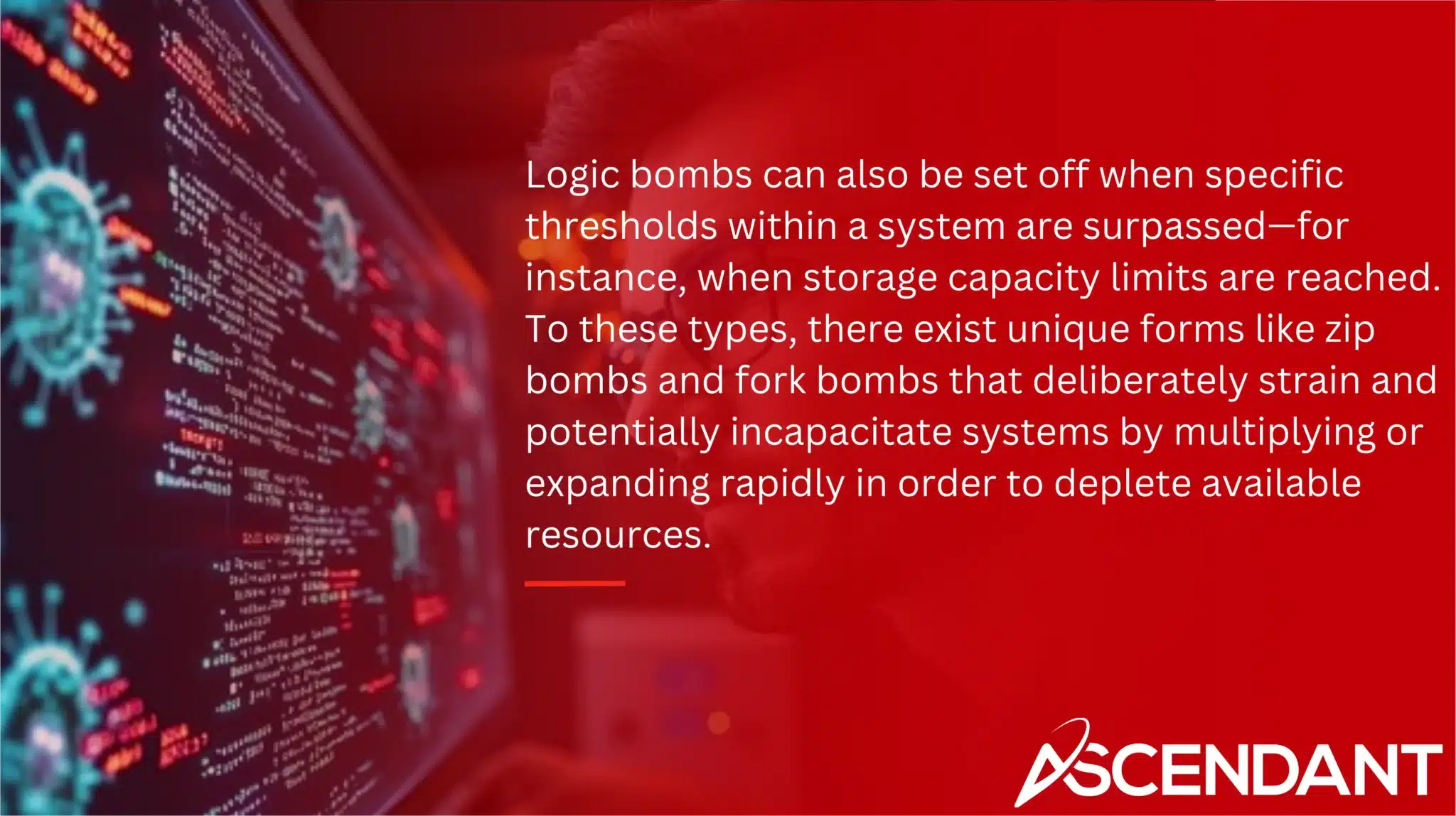A logic bomb is a hidden piece of malware that activates upon certain conditions. Instead of spreading, it waits silently within software to execute its harmful code. This article will explain what logic bombs are, give examples, and offer tips on preventing them.
In This Article:
- Understanding Logic Bombs
- How Logic Bombs Operate
- Characteristics of Logic Bombs
- Differences Between Logic Bombs and Other Malware
- Why Logic Bombs Are Dangerous
- Types of Logic Bombs
- Famous Logic Bomb Attacks
- Detecting and Preventing Logic Bombs
- Legal Implications of Logic Bombs
Key Takeaways
- Logic bombs are stealthy malware that activate under specific conditions, such as particular dates or events, making them difficult to detect until it’s too late.
- They differ from other malware types, such as viruses and worms, by remaining dormant until triggering conditions are met, requiring specialized cybersecurity measures for prevention.
- Notorious incidents, such as the UBS PaineWebber attack, illustrate the significant operational and financial damage that logic bombs can cause, emphasizing the need for robust monitoring and access control.
Understanding Logic Bombs
Logic bombs are a form of malicious software defined by their reliance on certain events to activate. Differing from standard malware that perpetuates itself autonomously, logic bombs lie inactive within computer systems until an external trigger—such as a specific date or occurrence like the firing of an employee—sets off the embedded code.
The threat posed by logic bombs stems from their capacity for concealment. Their ability to evade detection prior to execution renders them particularly insidious. These clandestine devices can embed themselves into genuine software through the aid of insiders with advanced privileges, lying in wait for their activation criteria to be fulfilled. Upon triggering, they have the capability to carry out various harmful actions including erasing files and corrupting data within a system, leading potentially to substantial disturbances such as initiating a logic bomb attack. Recognizing how these threats operate is key in forestalling them.
It’s critical for maintaining security across operating systems and computer networks that one comprehends the operational principles behind logic bombs’ event-based triggers and latent nature until execution time arrives. This insight lays down groundwork essential for unraveling Details regarding this kind of cyber menace’s functionality and characteristics, enabling better protection against possible incursions.
How Logic Bombs Operate

A logic bomb incorporates damaging instructions into programs that appear harmless. These harmful components lie inactive until they encounter certain triggers, at which point the logic bomb becomes active and carries out its destructive intent. The conditions for triggering these bombs can range from predetermined dates and times to intricate user interactions or system-related events.
Imagine a situation in which a logic bomb is programmed to go off on an exact date—similar to how a time bomb ticks away silently before detonation. Up until this designated moment, the malicious code stays hidden within the normal functions of the system software without any sign of its presence, allowing whoever set it up ample opportunity to obscure their involvement and making it quite difficult for those responsible for security to identify and stop it beforehand.
Understanding how these devices work is crucial when developing countermeasures against them.
Characteristics of Logic Bombs
Logic bombs are characterized by their covert nature. These pieces of malicious code tend to be skillfully concealed within legitimate software, rendering them quite challenging to spot. Such concealment is particularly favored by insiders with special system access who intend to inflict damage discreetly over time. As an example, a logic bomb could be set up to activate upon the opening of a certain file or in response to a specific occurrence like the firing of an employee.
These logic bombs remain inactive and evade detection until their programmed conditions are met—a period that can extend over several years during which the bomb silently sits within the system awaiting its moment. Activation may result in anything from trivial nuisances such as displaying comical messages all the way through catastrophic outcomes including data loss or total system failure—effects seen when critical systems get shut down unexpectedly or when memory gets wiped clean causing considerable interruptions in operations.
The wide range of potential triggers for these bombs, along with their varying impact levels, makes them particularly sinister threats. It doesn’t matter if it’s a trigger associated with completing an action (like accessing a particular document) or one related to preventing something (such as excising a developer’s credentials from company records), either scenario has potential for grave destruction.
This unpredictability and hidden aspect underscore how crucial stringent security measures against cyber threats have become.
Differences Between Logic Bombs and Other Malware
Logic bombs represent a distinct category of malware, separate from the likes of viruses and worms. Unlike their counterparts that disseminate without user intervention, logic bombs conceal themselves within a system and await pre-defined conditions to initiate their malicious payload. This reliance on particular triggers differentiates them from autonomous spreading entities such as computer viruses, which proliferate irrespective of specific events.
Logic bombs frequently serve in conjunction with other forms of malware, enhancing the overall destructive potential when deployed together. For instance, embedded within a computer worm’s code could be a dormant bomb primed to explode upon encountering certain systems or following an end-user’s actions. The conjoined forces can catalyze an even more catastrophic attack once the bomb is activated alongside the dissemination capabilities of its associated malware.
In contrast to self-replicating viruses that propagate independently through networks and devices, logic bombs hinge entirely on external event-based cues for activation. Their dependence on precise triggers renders them more elusive adversaries compared to straightforward varieties of harmful software. It’s essential for cybersecurity methodologies to acknowledge these differences in order to effectively address varied cyber threats.
Why Logic Bombs Are Dangerous
The clandestine and unpredictable characteristics of logic bombs are what render them so dangerous. They remain dormant, evading detection for an indefinite period until a particular set of circumstances triggers their activation. At the precise moment of activation—often unexpected—they can wreak havoc on unsuspecting victims.
Logic bomb attacks vary in the magnitude of destruction they inflict, with outcomes ranging from service disruptions to corruption of vital data that may lead to substantial operational and financial repercussions. In severe instances, these digital explosives have the potential to debilitate an entire organization’s information technology framework, causing significant interruptions in operation and losses of critical data. The extent of damage inflicted is contingent upon both how the attacker has configured the bomb as well as which specific conditions were pre-established for its detonation.
What makes logic bombs particularly menacing is their capability to initiate long after being planted, allowing attackers ample time to obfuscate their involvement thus hindering investigations post-attack. This element not only provides attackers with a tactical advantage through surprise but also underscores why there’s an imperative need for strong cybersecurity defenses capable of detecting and neutralizing such lurking threats before they strike.
Types of Logic Bombs
Various incarnations of logic bombs exist, each designed with distinct activation conditions and detrimental consequences. The time bomb variant is specifically configured to launch based on chronological progression. Such a bomb routinely checks the system’s clock until it reaches an appointed moment, at which point it unleashes its destructive payload. Time bombs are typically used by attackers who wish to distance themselves from the incident prior to detonation, thereby reducing their chances of detection.

Logic bombs can also be set off when specific thresholds within a system are surpassed—for instance, when storage capacity limits are reached. To these types, there exist unique forms like zip bombs and fork bombs that deliberately strain and potentially incapacitate systems by multiplying or expanding rapidly in order to deplete available resources. Recognizing the spectrum of logic bomb variations is crucial for spotting potential hazards and devising effective security measures against them.
Famous Logic Bomb Attacks
Numerous historical examples have demonstrated the considerable harm that logic bombs can inflict, highlighting the critical need for strong cybersecurity defenses. The severe fallout from prominent logic bomb attacks serves as a stark reminder of the destructive power of this malicious code and accentuates the importance of being alert and adopting preventative measures to guard against such threats. It’s crucial to analyze past events to avoid recurrence of similar assaults.
We will examine three significant instances: the UBS PaineWebber event, Siemens Corporation scenario, and the Stuxnet worm attack. These cases offer insightful revelations about how damaging logic bombs can be and reinforce just how essential robust cyber protection is.
The UBS PaineWebber Incident
The incident at UBS PaineWebber serves as a stark warning of the potential harm that can be inflicted by dissatisfied employees. Roger Duronio, reacting to his termination, planted a logic bomb within the company’s infrastructure programmed to detonate on an appointed day. On reaching this trigger date, it erased vital information and led to considerable interruption in operations.
Substantial loss of data and financial detriment ensued for UBS PaineWebber as a result of Duronio’s deed. This event highlights the critical need for vigilant oversight concerning internal threats and robust measures in controlling access to safeguard against such destructive occurrences.
The Siemens Corporation Case
David Tinley designed logic bombs within Siemens software to trigger malfunctions under specific conditions, enabling him to bill for necessary repairs. These bombs lay inactive until triggering criteria were satisfied, at which point they caused system breakdowns that Tinley used to his financial advantage.
In 2019, Tinley admitted his guilt regarding these actions and was subsequently subject to legal consequences, potentially including time behind bars. This incident underscores the critical nature of conducting consistent audits and oversight of systems in order to uncover any illicit modifications indicative of a logic bomb’s existence.
Stuxnet and Its Logic Bomb Component
Stuxnet, an intricate computer worm, was intentionally crafted to hinder the progress of Iran’s nuclear enrichment installations. It made use of logic bombs which activated under predetermined conditions, leading to the malfunctioning of physical apparatus and causing notable impediments in the Iranian nuclear endeavor. This deployment of logic bombs as a means to incapacitate centrifuges exemplifies their formidable capabilities within the realm of cyber warfare.
The repercussions triggered by Stuxnet were considerable, demonstrating how devastatingly effective logic bombs can be when employed in cyber assaults backed by nations. This event highlights the imperative for robust cybersecurity measures that protect vital infrastructure against advanced threats such as these.
Detecting and Preventing Logic Bombs
To effectively detect and avert logic bomb attacks, one must adopt an intricate strategy. The inherent unpredictability of their activation mechanisms combined with their knack for camouflaging within authentic software renders them especially elusive. Through frequent scanning of files and the implementation of code examinations along with automated security assessments, one can aid in revealing concealed logic bombs that may be lurking within the software.
The employment of secure coding practices, keeping software regularly updated, and maintaining routine backups constitute critical defensive measures against logic bomb attacks. Embedding these methods into your cybersecurity regime drastically lowers the likelihood of such bombs being successfully deployed.
Secure Coding Practices
Implementing secure coding practices is essential for eliminating weaknesses that can be taken advantage of by logic bombs. By incorporating DevSecOps, security measures become an integral part of the software development lifecycle, which diminishes the likelihood of logic bombs being incorporated. This forward-thinking strategy detects and addresses possible dangers while software is still being created.
Giving precedence to secure coding practices reduces the chances of programming mistakes and redundant code known as slag code, which malevolent individuals might leverage. Such precautions strengthen defenses against logic bombs in software and improve general cybersecurity robustness.
Regular System Audits
Conducting systematic audits is crucial to detect any unauthorized modifications that could signal the presence of a logic bomb. These evaluations can reveal unapproved scheduled tasks, alterations in system settings, and unusual code variations which may be indicative of potential logic bombs.
By consistently auditing systems, their integrity is preserved and the early identification of unsanctioned activities becomes possible. This allows for prompt action to prevent a logic bomb from inflicting harm on the system, underscoring its significance as an essential aspect of strong cybersecurity measures.
Employee Monitoring and Access Control
Employee monitoring and access control prevent insider threats that could lead to logic bomb deployment. Role-based access control limits user access to sensitive information, reducing the risk of malicious insiders. Network Access Control (NAC) ensures only authenticated users access the system, further mitigating threats.
Regular employee training on spotting unusual computer system behavior empowers staff to identify potential logic bomb activities early, enhancing overall security. Monitoring user actions and access helps prevent unauthorized actions that could introduce logic bombs.
Legal Implications of Logic Bombs
Deploying logic bombs carries grave legal consequences due to their illicit nature and the potential damage they can inflict. Individuals engaging in such activities, exemplified by Roger Duronio who was sentenced to more than eight years in a federal penitentiary along with facing hefty financial penalties, are subject to stringent punitive actions.
Incidents involving organizations such as UBS PaineWebber and Siemens Corporation underscore the importance of enforcing rigorous access control and surveillance procedures to ward off threats from within. It is crucial for companies to establish strong security measures that safeguard against the introduction of logic bombs while adhering to established legal frameworks.
Summary
To summarize, logic bombs pose a covert yet substantial risk to digital systems due to their capacity for lying in wait undetected until activated by certain conditions. It is essential to grasp the nature and functioning of these threats, along with the critical role that strong cybersecurity practices play in safeguarding against them. Organizations can lessen the danger posed by logic bombs and maintain their systems’ integrity through knowledge gleaned from previous incidents and the adoption of anticipatory security tactics.
 Frequently Asked Questions
Frequently Asked Questions
What is a logic bomb?
A logic bomb remains dormant within a system as a type of malicious software until it is activated when specific conditions are fulfilled. Once triggered, it releases its damaging payload into the system.
It is vital to comprehend the activation criteria of such malware in order to implement robust cybersecurity defenses effectively.
How do logic bombs differ from viruses?
Unlike viruses, which propagate on their own, logic bombs stay inactive and do not self-replicate. They are distinguished by the unique triggering conditions required for their activation.
What are some famous logic bomb attacks?
Famous logic bomb attacks include the UBS PaineWebber incident, the Siemens Corporation case, and the Stuxnet worm’s sabotage of Iran’s nuclear facilities, all of which resulted in considerable damage.
These incidents highlight the potential severity of such cyber threats.
How can organizations prevent logic bomb attacks?
Organizations can effectively prevent logic bomb attacks by employing secure coding practices, conducting regular system audits, monitoring employee actions, and implementing robust access controls.
These measures help safeguard against potential internal threats and enhance overall security.
What are the legal consequences of deploying a logic bomb?
The act of implementing a logic bomb is against the law and can result in severe legal consequences, such as extended incarceration periods and substantial monetary penalties, which have been evident in well-publicized incidents.
Comprehending the grave outcomes associated with these actions is essential.

